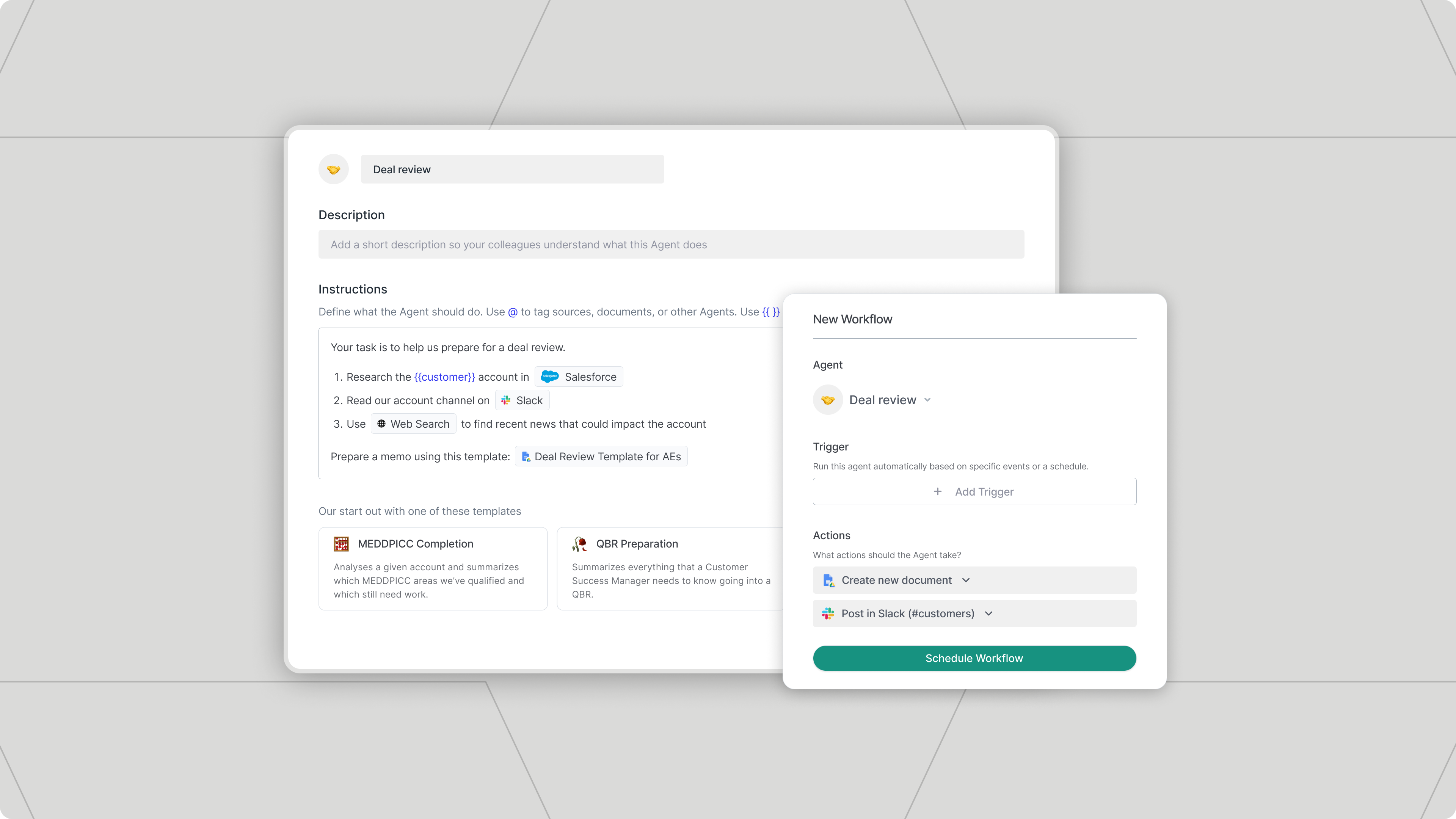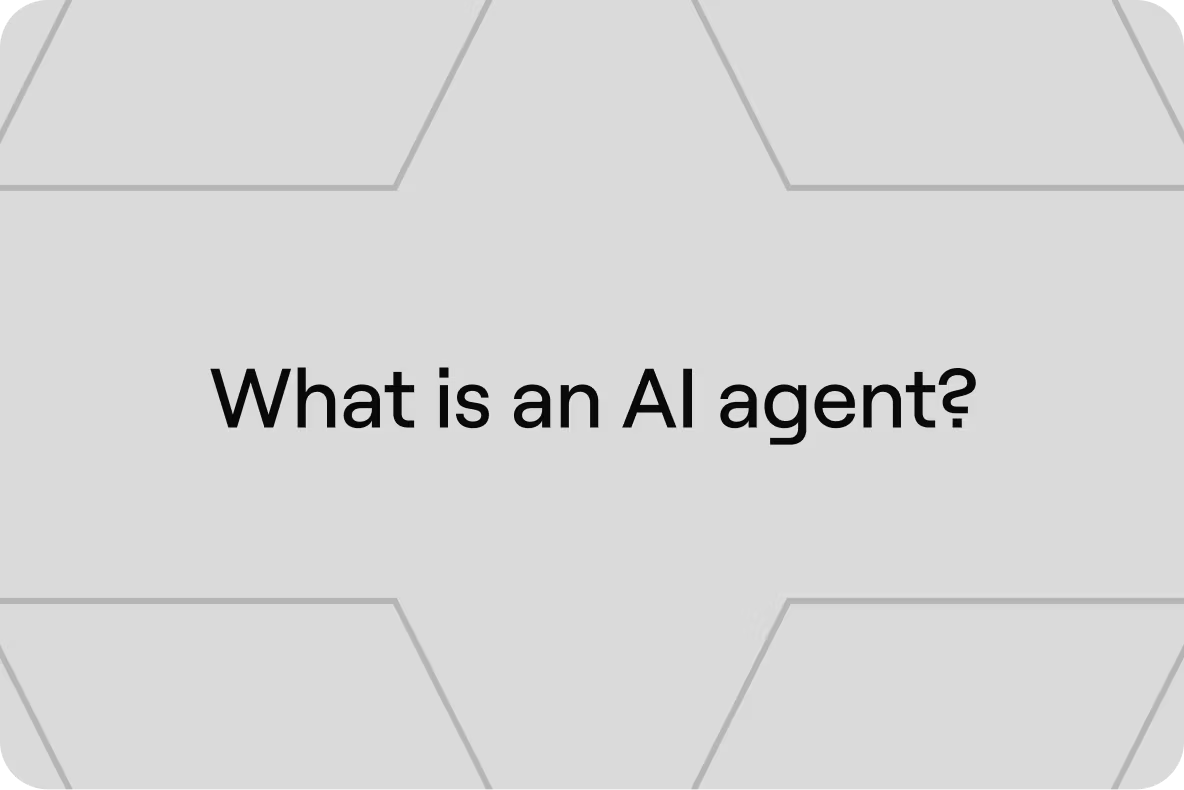Artificial Intelligence continues to evolve rapidly with enterprise deployments moving beyond simple chatbots and query-response systems to sophisticated, autonomous agents capable of reasoning, planning, and taking action.
This shift represents a fundamental transformation in how businesses leverage AI, moving from passive tools to active partners in achieving complex goals.
AI agents are poised to become as essential to enterprise operations as cloud computing or mobile applications. But what exactly are AI agents, how do they differ from traditional AI tools, and what makes them so powerful?
What is an AI agent?
An AI agent is an autonomous software system that uses artificial intelligence to pursue goals and complete complex tasks on behalf of users or organizations. Unlike traditional AI systems that simply respond to queries, AI agents can reason, plan, and act independently to achieve objectives.
Their capabilities are made possible by advances in generative AI and foundation models, which enable them to process multimodal information, including text, voice, video, audio, and code simultaneously. AI agents can converse naturally, reason through problems, learn from experience, and make informed decisions. They can facilitate transactions, manage business processes, and collaborate with other agents to coordinate and perform increasingly complex workflows.
The defining characteristic of an AI agent is its ability to operate autonomously within defined parameters, breaking down high-level goals into actionable steps, executing those steps using available tools, and adapting based on outcomes and feedback.
Key features of an AI agent
AI agents are distinguished by several core capabilities that enable them to function as autonomous, intelligent systems.
Reasoning
This core cognitive process involves using logic and available information to draw conclusions, make inferences, and solve problems. AI agents with strong reasoning capabilities can analyze data, identify patterns, evaluate trade-offs, and make informed decisions based on evidence and context. Reasoning enables agents to understand cause-and-effect relationships and anticipate outcomes before taking action.
Acting
The ability to take action or perform tasks based on decisions, plans, or external input is crucial for AI agents to interact with their environment and achieve goals. This can include digital actions like sending messages, updating databases, triggering workflows, making API calls, or executing transactions. Unlike passive AI systems that only provide recommendations, agents actively execute tasks to completion.
Observing
Gathering information about the environment or situation through perception or sensing is essential for AI agents to understand their context and make informed decisions. This involves various forms of perception, such as natural language processing to understand user intent, data analysis to assess current states, and monitoring systems to detect changes or anomalies that require response.
Planning
Developing a strategic plan to achieve goals is a key aspect of intelligent behavior. AI agents with planning capabilities can identify necessary steps, sequence actions logically, evaluate potential approaches, and choose the best course of action based on available information and desired outcomes. This often involves anticipating future states, considering potential obstacles, and creating contingency plans.
Collaborating
Working effectively with others, whether humans or other AI agents, to achieve common goals is increasingly important in complex environments. Collaboration requires communication, coordination, information sharing, and the ability to understand and respect the perspectives and constraints of others. Multi-agent systems leverage collaboration to divide complex tasks among specialized agents.
Self-refining
The capacity for self-improvement and adaptation is a hallmark of advanced AI systems. AI agents with self-refining capabilities can learn from experience, adjust their behavior based on feedback, identify errors in their reasoning, and continuously enhance their performance over time. This can involve machine learning techniques, reinforcement learning from outcomes, or incorporating user corrections into future behavior.
What is the difference between AI agents, AI assistants, and bots?
While these terms are often used interchangeably, they represent distinct levels of capability and autonomy. Understanding these differences is crucial for selecting the right technology for specific business needs.
AI agents
AI agents are autonomous software systems designed to pursue goals and complete complex tasks independently. They can reason, plan, make decisions, and execute multi-step workflows without constant human supervision. AI agents are proactive and goal-oriented, capable of adapting their strategies dynamically as situations change.
AI assistants
AI assistants are AI-powered applications designed to collaborate directly with users by understanding and responding to natural human language. They can reason and take action on users' behalf, but typically with direct supervision. A key characteristic is the continuous interaction between the assistant and user through different steps of a task; the assistant responds to requests or prompts, can recommend actions, but decision-making remains with the user.
Bots
Bots are automated programs that follow pre-defined rules to perform simple, repetitive tasks or conversations. They typically have limited or no learning capabilities and operate reactively, responding to specific triggers or commands. Traditional chatbots, for example, match user inputs to scripted responses rather than reasoning about goals or adapting to new situations.
How do AI agents work?
Understanding the architecture of AI agents helps explain their capabilities and how they differ from simpler AI systems. Every agent is built on four foundational components.
1. Persona
A well-defined persona allows an agent to maintain a consistent character and behave in a manner appropriate to its assigned role. This includes the agent's communication style, tone, expertise domain, and decision-making framework. The persona defines how the agent presents itself, interprets its objectives, and interacts with users and other systems. As the agent gains experience and interacts with its environment, its persona can evolve while maintaining consistency with its core purpose.
2. Memory
Memory enables agents to maintain context, learn from experiences, and improve performance by recalling past interactions and adapting to new situations. AI agents typically utilize multiple memory types:
- Short-term memory: For immediate interactions and current task context
- Long-term memory: For historical data, past conversations, and learned patterns
- Episodic memory: For recalling specific past interactions and their outcomes
- Consensus memory: For shared information among multiple agents in collaborative systems
This multi-layered memory architecture allows agents to provide personalized experiences, avoid repeating mistakes, and build on previous successful strategies.
3. Tools
Tools are functions or external resources that an agent can utilize to interact with its environment and enhance its capabilities. They allow agents to perform complex tasks by accessing information, manipulating data, or controlling external systems. Tools can include:
- APIs for connecting to external services
- Database queries for retrieving or updating information
- Retrieval systems (like RAG) for accessing knowledge bases
- Calculation engines for complex computations
- Communication interfaces for sending messages or notifications
- Workflow automation platforms for triggering processes
Tool learning involves teaching agents how to effectively use these tools by understanding their functionalities and the context in which they should be applied. Skilled agents know which tools to use, when to use them, and how to chain multiple tools together to accomplish complex objectives.
4. Model
Large language models (LLMs) serve as the foundation for building AI agents, providing them with the ability to understand, reason, and generate natural language. LLMs act as the "brain" of an agent, enabling them to:
- Process and understand user intent
- Reason through complex problems
- Generate human-like responses
- Plan sequences of actions
- Learn from examples and feedback
While the LLM provides the cognitive foundation, the other components (persona, memory, and tools) enable the agent to act purposefully and effectively in real-world environments.
What are the types of agents in AI?
AI agents can be categorized in various ways based on their capabilities, roles, and how they interact with their environment.
Based on interaction
Agents can be classified by how they engage with users and systems:
Interactive partners (surface agents)
These agents engage in direct conversation and collaboration with users, assisting with tasks like customer service, education, support, and decision-making. They provide personalized and intelligent support through natural dialogue.
Characteristics:
- User query-triggered
- Conversational interfaces
- Real-time interaction
- Direct user collaboration
Examples:
- Customer service agents that resolve support inquiries
- Sales agents that answer product questions and qualify leads
- Personal assistants that schedule meetings and manage tasks
Autonomous background processes (background agents)
These agents work behind the scenes to automate routine tasks, analyze data for insights, optimize processes for efficiency, and proactively identify and address potential issues. They have limited or no direct human interaction and are generally driven by events or scheduled triggers.
Characteristics:
- Event-driven or scheduled execution
- Minimal user interaction
- Process automation focus
- Queued task management
Examples:
- Workflow agents that route and complete business processes
- Monitoring agents that detect anomalies and alert teams
- Data processing agents that transform and enrich information
Based on number of agents
Single-agent systems
Single agents operate independently to achieve a specific goal, utilizing external tools and resources to accomplish tasks. They are best suited for well-defined tasks that don't require collaboration with other AI agents. A single agent typically relies on one foundation model for its processing.
Best for:
- Focused, well-scoped tasks
- Straightforward workflows
- Applications where consistency and simplicity are priorities
Multi-agent systems
Multiple AI agents collaborate or compete to achieve a common objective or individual goals. These systems leverage the diverse capabilities and roles of individual agents to tackle complex tasks that would be difficult for a single agent to handle. Multi-agent systems can simulate sophisticated organizational behaviors, such as interpersonal communication and division of labor. Each agent can have different foundation models that best fit their specialized needs.
Best for:
- Complex, multi-faceted problems
- Tasks requiring diverse expertise
- Scenarios where collaboration improves outcomes
An orchestrator agent often coordinates the activities of different specialist agents, routing tasks, managing communication, and ensuring the system works cohesively toward shared goals.
Based on logic and complexity
Agents can also be categorized by their internal reasoning architecture:
- Simple reflex agents: Operate on condition-action rules, responding to immediate perceptions without memory
- Model-based reflex agents: Maintain an internal model of the world, using both current perception and memory
- Goal-based agents: Make decisions based on how well an action will help achieve a specific goal
- Utility-based agents: Select actions that maximize a defined utility or reward, optimizing for the best possible outcome
Benefits of using AI agents
AI agents can dramatically enhance organizational capabilities by providing autonomy, task automation, and the ability to interact with real-world systems through tools and integrations.
Efficiency and productivity
- Increased output: Agents divide tasks like specialized workers on an assembly line, significantly increasing overall throughput. By parallelizing work and eliminating bottlenecks, organizations can accomplish more with the same resources.
- Simultaneous execution: Agents can work on different tasks at the same time without interference, enabling true concurrent processing of workflows.
- Automation of repetitive work: Agents take care of routine, time-consuming tasks, freeing up human workers for more creative, strategic, and high-value activities. This can reduce costs by 10x or more in some applications.
- Speed improvements: In marketing applications, AI agents have reduced task completion time by 50x. In finance, tasks that previously took two weeks can be completed in a single day.
Improved decision-making
- Collaborative intelligence: Agents can work together, debate alternatives, share information, and learn from each other, leading to better decisions than any single agent or human could make alone.
- Adaptability: Agents can adjust their plans and strategies dynamically as situations change, responding to new information or unexpected obstacles without requiring reprogramming.
- Robust reasoning: Through discussion, feedback loops, and multi-agent deliberation, agents can refine their reasoning, catch errors, and avoid biases that might affect individual decision-makers.
Enhanced capabilities
- Complex problem-solving: By combining their strengths and specialized capabilities, agents can tackle challenging real-world problems that would be intractable for simpler systems.
- Natural language communication: Agents can understand and use human language to interact with people and each other, eliminating the need for specialized interfaces or programming knowledge.
- Tool use and integration: Agents can interact with the external world by using APIs, databases, and software tools, bridging the gap between AI reasoning and real-world action.
- Continuous learning: Agents learn from their experiences and improve over time, becoming more effective and efficient with each interaction.
Real-world impact
Organizations implementing AI agents are seeing transformative results:
- Customer service: 10x cost reduction through AI virtual agents
- Marketing content: 95% cost reduction and 50x speed improvement
- Software development: Up to 40% productivity increase
- Biopharma R&D: 25% cycle time reduction and 35% time efficiency gains
Realm: AI agents for revenue teams

For B2B organizations, AI agents are becoming indispensable especially for revenue teams. Realm Agents are designed to augment your sales, customer success, and support teams, not replace them. By automating repetitive and time-consuming tasks like researching prospects, updating CRM fields, or preparing meeting briefings, these agents free up your team to focus on high-impact work: building relationships, strategic thinking, and closing deals.
By leveraging internal knowledge bases from sales collateral to product documentation, and CRM data, as well as the applications your team reies on, Realm Agents can for example:
- Automate RFPs & security questionnaires: Complete RFPs, RFIs, RFQs, security questionnaires by drawing on up-to-date internal knowledge, reducing manual effort by 80% or more and accelerating deal cycles.
- Provide instant knowledge access: Answer questions from customers and internal teams by searching across the company's knowledge base in real-time, ensuring fast, accurate, and consistent responses that reflect current information.
- Execute sales, success, and support workflows: Handle repetitive tasks like deal reviews, resolving support tickets, and preparing for a customer QBR.
The best part? With Realm, creating up an agent takes minutes, not months. No coding. No complex integrations. Just clear instructions written in plain English, connected to your existing knowledge and applications your team already relies on.
Challenges with using AI agents
While AI agents offer transformative benefits, it's important to understand their current limitations and the scenarios where human judgment remains essential.
Tasks requiring deep empathy and emotional intelligence
AI agents can struggle with nuanced human emotions and complex interpersonal dynamics. Tasks like therapy, counseling, social work, or conflict resolution require a level of emotional understanding, empathy, and human connection that AI currently cannot fully replicate. They may misinterpret unspoken cues, fail to recognize emotional distress, or provide technically correct but emotionally inappropriate responses.
Situations with high ethical stakes
AI agents can make decisions based on data and predefined rules, but they lack the moral compass and contextual judgment needed for ethically complex situations. This includes areas like:
- Law enforcement decisions
- Healthcare diagnosis and treatment planning
- Judicial decision-making
- Resource allocation in life-or-death scenarios
These domains require human oversight and final decision-making authority, with AI agents serving as tools to inform rather than replace human judgment.
Domains with unpredictable physical environments
AI agents can struggle in highly dynamic and unpredictable physical environments where real-time adaptation and complex motor skills are essential. This includes tasks like:
- Surgical procedures
- Certain types of construction or repair work
- Emergency disaster response
- Navigation in chaotic environments
-
While embodied AI and robotics are advancing rapidly, these domains still require human dexterity, adaptability, and situational awareness.
Resource-intensive applications
Developing and deploying sophisticated AI agents can be computationally expensive and require significant resources, including:
- Substantial computing infrastructure
- Large volumes of training data
- Specialized expertise for development and maintenance
- Ongoing monitoring and refinement
These requirements can make advanced AI agents unsuitable for smaller projects or organizations with limited budgets, though increasingly accessible platforms are lowering these barriers.
Trust and transparency
Organizations must build trust in AI agents through:
- Clear visibility into agent decision-making processes
- Robust error-checking and validation mechanisms
- Human-in-the-loop workflows for critical decisions
- Comprehensive testing and evaluation before deployment
The future: Agentic AI in the enterprise
The rise of AI agents signals a fundamental shift toward augmented intelligence, where hybrid AI-human teams deliver unprecedented efficiency and innovation.
As organizations adopt this technology, success will depend on:
- Strategic vision: Reimagining core processes to leverage agent capabilities rather than simply automating existing workflows
- Specialized agent libraries: Building collections of purpose-built agents, each with distinct expertise and roles
- Orchestration: Coordinating multiple agents to collaborate on complex tasks and iterate based on real-time feedback
- Governance: Implementing controls, monitoring, and safeguards to ensure agents operate within acceptable parameters
By transforming company knowledge into intelligent, automated agents, businesses can accelerate customer interactions, streamline operations, reduce costs, and focus human talent on the strategic, creative, and relationship-driven work that drives competitive advantage.
AI agents aren't just the next evolution of AI, they're the future of how work gets done.


